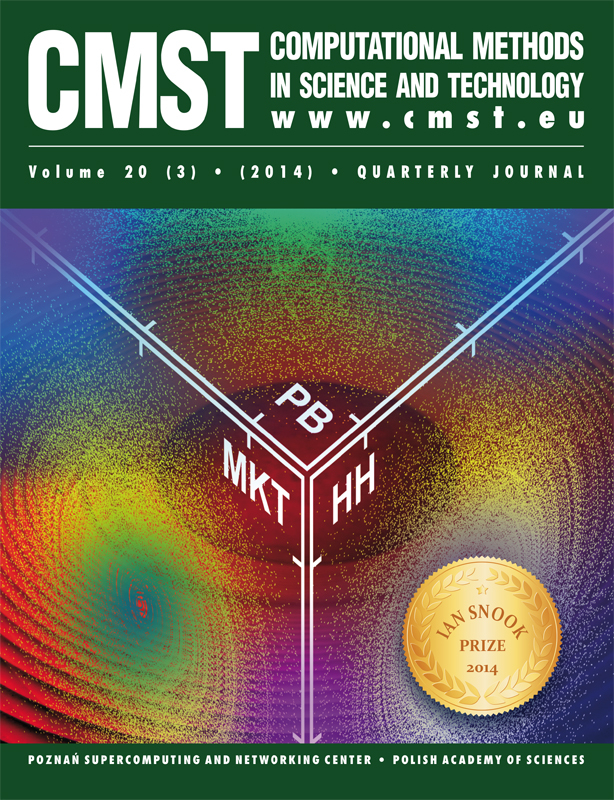Information Dimensions of Simple Four-Dimensional Flows
Hoover William G. 1†, Hoover Carol G. 1‡, Travis Karl P. 2
1 Ruby Valley Research Institute
601 Highway Contract 60
Ruby Valley, Nevada 89833, USA
† E-mail: hooverwilliam@yahoo.com
‡ E-mail: hoover1carol@yahoo.com2 University of Sheffield
Department of Materials Science and Engineering
Sheffield S1 3JD, United Kingdom
Received:
Received: 4 July 2023; in final form: 13 July 2023; accepted: 14 July 2023; published online: 30 July 2023
DOI: 10.12921/cmst.2023.0000017
Abstract:
Baker Maps have long served as pedagogical tools for understanding chaos and fractal phase-space distributions. Recent work [1], following earlier efforts from 1997 [2], shows that the Kaplan-Yorke formula for information dimension disagrees with direct computation for some simple compressible Baker Maps. Here we extend this map work to simple continuous flows. We compare pointwise information dimensions to the Kaplan-Yorke dimension for a simple four-dimensional flow [3] controlling both ⟨p^4⟩ and ⟨p^2⟩: { q˙ = p ; p˙ = −q − ξp^3 − ζp ; ξ˙ = p^4 − 3p^2 ; ζ˙ = p^2 − T }. Precisely similar sets of Gaussian points could be generated with Metropolis’ Monte-Carlo simulations of harmonic oscillators in Gibbs’ canonical ensemble with f (q) = (e^(−q ^2/2))/sqrt(2π). Remarkably, we show that the dependence of the pointwise information dimension for the Gaussian distribution is linear in the inverse of the logarithm of the mesh spacing, ∝ 1/ ln(1/δ). The Hoover-Holian Gaussian oscillator problem [3] can be generalized [2–4] to some nonequilibrium steady-state problems by introducing a temperature-gradient parameter ϵ. In that case the temperature T varies from 1 − ϵ to 1 + ϵ : T = 1 + ϵ tanh(q) so that both conservative (ϵ = 0) and dissipative (ϵ > 0) flows result.
Key words:
Baker Map, fractals, information dimension, Kaplan-Yorke dimension
References:
[1] W.G. Hoover, C.G. Hoover, A Quarter Century of Baker Map Exploration, Computational Methods in Science and Technology 29, 5–16 (2023).
[2] H.A. Posch, W.G. Hoover, Time-Reversible Dissipative Attractors In Three And Four Phase-Space Dimensions, Physical Review E 55, 6803–6810 (1997).
[3] W.G. Hoover, B.L. Holian, Kinetic Moments Method for the Canonical Ensemble Distribution, Physics Letters A 211, 253–257 (1996).
[4] W.G. Hoover, Compressible Baker Maps and Their Inverses. A Memoir for Francis Hayin Ree [1936–2020], Computational Methods in Science and Technology 26, 5–13 (2020).
[5] T. Tél, M. Gruiz, Chaotic Dynamics; An Introduction Based on Classical Mechanics, Cambridge University Press (2006).
[6] J.C. Sprott, W.G. Hoover, C.G. Hoover, Heat Conduction, and the Lack Thereof, in Time-Reversible Dynamical Systems: Generalized Nosé-Hoover Oscillators with a Temperature Gradient, Physical Review E 89, 042914 (2014).
Baker Maps have long served as pedagogical tools for understanding chaos and fractal phase-space distributions. Recent work [1], following earlier efforts from 1997 [2], shows that the Kaplan-Yorke formula for information dimension disagrees with direct computation for some simple compressible Baker Maps. Here we extend this map work to simple continuous flows. We compare pointwise information dimensions to the Kaplan-Yorke dimension for a simple four-dimensional flow [3] controlling both ⟨p^4⟩ and ⟨p^2⟩: { q˙ = p ; p˙ = −q − ξp^3 − ζp ; ξ˙ = p^4 − 3p^2 ; ζ˙ = p^2 − T }. Precisely similar sets of Gaussian points could be generated with Metropolis’ Monte-Carlo simulations of harmonic oscillators in Gibbs’ canonical ensemble with f (q) = (e^(−q ^2/2))/sqrt(2π). Remarkably, we show that the dependence of the pointwise information dimension for the Gaussian distribution is linear in the inverse of the logarithm of the mesh spacing, ∝ 1/ ln(1/δ). The Hoover-Holian Gaussian oscillator problem [3] can be generalized [2–4] to some nonequilibrium steady-state problems by introducing a temperature-gradient parameter ϵ. In that case the temperature T varies from 1 − ϵ to 1 + ϵ : T = 1 + ϵ tanh(q) so that both conservative (ϵ = 0) and dissipative (ϵ > 0) flows result.
Key words:
Baker Map, fractals, information dimension, Kaplan-Yorke dimension
References:
[1] W.G. Hoover, C.G. Hoover, A Quarter Century of Baker Map Exploration, Computational Methods in Science and Technology 29, 5–16 (2023).
[2] H.A. Posch, W.G. Hoover, Time-Reversible Dissipative Attractors In Three And Four Phase-Space Dimensions, Physical Review E 55, 6803–6810 (1997).
[3] W.G. Hoover, B.L. Holian, Kinetic Moments Method for the Canonical Ensemble Distribution, Physics Letters A 211, 253–257 (1996).
[4] W.G. Hoover, Compressible Baker Maps and Their Inverses. A Memoir for Francis Hayin Ree [1936–2020], Computational Methods in Science and Technology 26, 5–13 (2020).
[5] T. Tél, M. Gruiz, Chaotic Dynamics; An Introduction Based on Classical Mechanics, Cambridge University Press (2006).
[6] J.C. Sprott, W.G. Hoover, C.G. Hoover, Heat Conduction, and the Lack Thereof, in Time-Reversible Dynamical Systems: Generalized Nosé-Hoover Oscillators with a Temperature Gradient, Physical Review E 89, 042914 (2014).

